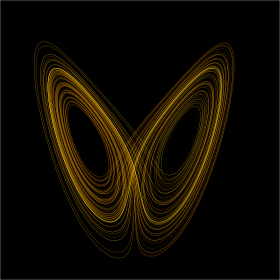Portal:Systems science
The systems science portal
 |
| Complex systems approach |
Systems science is an transdisciplinary[1] field that studies the nature of systems—from simple to complex—in nature, society, cognition, engineering, technology and science itself. To systems scientists, the world can be understood as a system of systems. The field aims to develop interdisciplinary foundations that are applicable in a variety of areas, such as psychology, biology, medicine, communication, business management, engineering, and social sciences.
Systems science covers formal sciences such as complex systems, cybernetics, dynamical systems theory, information theory, linguistics or systems theory. It has applications in the field of the natural and social sciences and engineering, such as control theory, operations research, social systems theory, systems biology, system dynamics, human factors, systems ecology, systems engineering and systems psychology. Themes commonly stressed in system science are (a) holistic view, (b) interaction between a system and its embedding environment, and (c) complex (often subtle) trajectories of dynamic behavior that sometimes are stable (and thus reinforcing), while at various 'boundary conditions' can become wildly unstable (and thus destructive). Concerns about Earth-scale biosphere/geosphere dynamics is an example of the nature of problems to which systems science seeks to contribute meaningful insights.
Selected article -
The Manila Metro Rail Transit System (MRTS), commonly known as the MRT, is a rapid transit system that primarily serves Metro Manila, Philippines. Along with the Manila Light Rail Transit System and the Metro Commuter Line of the Philippine National Railways, the system makes up Metro Manila's rail infrastructure.
The MRT's 16.9-kilometer-route consists of 1 line and 13 stations (in operation). The first and the only line currently in operation, MRT Line 3 is jointly operated between the Metro Rail Transit Corporation, a privately owned company, and the Department of Transportation (DOTr) through a Build-Lease-Transfer agreement. Line 3 was opened in December 1999 and completed in July 2000. (Full article...)Selected picture

The Lorenz attractor is a 3-dimensional structure corresponding to the long-term behavior of a chaotic flow, noted for its butterfly shape. The map shows how the state of a dynamical system (the three variables of a three-dimensional system) evolves over time in a complex, non-repeating pattern.
The attractor itself, and the equations from which it is derived, were introduced by Edward Lorenz in 1963, who derived it from the simplified equations of convection rolls arising in the equations of the atmosphere.
'WikiProjects
Selected biography -
Herman Kahn (February 15, 1922 – July 7, 1983) was an American physicist and a founding member of the Hudson Institute, regarded as one of the preeminent futurists of the latter part of the twentieth century. He originally came to prominence as a military strategist and systems theorist while employed at the RAND Corporation. He analyzed the likely consequences of nuclear war and recommended ways to improve survivability during the Cold War. Kahn posited the idea of a "winnable" nuclear exchange in his 1960 book On Thermonuclear War for which he was one of the historical inspirations for the title character of Stanley Kubrick's classic black comedy film satire Dr. Strangelove. In his commentary for Fail Safe, director Sidney Lumet remarked that the Professor Groeteschele character is also based on Herman Kahn.
Kahn's theories contributed to the development of the nuclear strategy of the United States. (Full article...)Did you know
- ... that the American ecologist Howard T. Odum in 1950 gave a novel definition of ecology as the study of large entities (ecosystems) at the "natural level of integration".
- ... that a successful experimental system must be stable and reproducible enough for scientists to make sense of the system's behavior, but unpredictable enough that it can produce useful results?
- ... that a multi-agent system (MAS) is a system composed of multiple interacting intelligent agents, which can be used to solve problems which are impossible for monolithic system to solve.
- ... that American systems theorist Debora Hammond in the new millennium explores new ways of thinking about complex systems that support more participatory forms of social organization?
Categories
Related portals
Topics
Tasks
 |
Here are some tasks awaiting attention:
|















